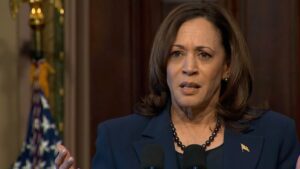
NPR News
The upcoming vice-presidential debate between Minnesota Governor Tim Walz and Ohio Senator J.D. Vance is shaping up to be a pivotal moment for both candidates. Walz, whose handling of the 2020 Minnesota riots and transgender policies in schools has come under intense scrutiny, faces off against Vance, a rising conservative star whose clear stance on law and order has garnered attention. This debate will allow both candidates to present their visions on law enforcement, the economy, and cultural issues. Below, we break down the top 10 likely debate questions and provide insight into how each candidate may answer from a conservative perspective.
1. Handling of the Minnesota Riots: A Leadership Test
Question: “Governor Walz, you’ve been criticized for your response to the Minneapolis riots in 2020. Do you think your handling of the situation was effective in restoring peace, or would you change anything in hindsight?”
Walz’s Potential Answer:
Walz will likely try to defend his decision to allow protests, claiming it was a necessary balancing act between controlling civil unrest and respecting the demonstrators’ grievances. He may argue that his approach prevented further violence.
Vance’s Potential Answer:
Vance will likely condemn Walz’s actions as a blatant failure of leadership. He could point to the destruction of large portions of the city, including retail areas and a police station, which were set ablaze during the riots. Vance will likely emphasize that the area remains economically depressed, showing no signs of recovery, which he will attribute directly to Walz’s unwillingness to enforce law and order. Vance might frame this as proof that Democratic leaders let chaos reign when their priorities are skewed, asserting that a strong leader must protect both citizens and businesses.
2. Transgender Rights in Schools: Parental Rights vs. State Policy
Question: “Governor Walz, your administration supports gender-affirming policies in public schools, including allowing transgender students to use bathrooms that align with their gender identity and compete in sports accordingly. Senator Vance, what is your stance on these policies?”
Walz’s Potential Answer:
Walz will likely defend his stance, stating that gender-affirming policies are necessary to create safe and inclusive environments for all students, particularly marginalized groups. He may argue that his policies reflect modern equality standards and that they are essential for protecting students’ mental and emotional well-being.
Vance’s Potential Answer:
Vance will undoubtedly oppose these policies, particularly focusing on the implications for women’s rights under Title IX. He could argue that allowing biological males to use women’s bathrooms and compete in female sports undermines decades of progress in securing equal opportunities for women. Vance may accuse Walz of ignoring the rights of women and girls, whose hard-fought achievements in education and sports are now being threatened by progressive gender policies. Vance will likely frame this issue as not just a moral failing but a breach of fairness and common sense.
3. Economy and Inflation: What’s the Conservative Plan?
Question: “Senator Vance, inflation is hurting working-class families across the nation. What is your plan to stabilize the economy and bring relief to American households?”
Vance’s Potential Answer:
Vance will likely argue that inflation is the result of reckless Democratic spending and overregulation. He’ll advocate for conservative economic policies like tax cuts, deregulation, and energy independence, positioning these as solutions to bring down costs, create jobs, and restore economic stability. Expect him to champion small businesses and criticize the bloated federal government for driving up inflation with stimulus spending and subsidies.
Walz’s Potential Answer:
Walz will likely blame external factors, such as the COVID-19 pandemic and global supply chain disruptions. He could argue that Republicans’ tax cuts benefit only the wealthy, failing to offer any real relief to working-class families. Walz may push for more government intervention, such as federal programs to lower costs for essential goods like food and gas.
4. Crime and Public Safety: Law Enforcement vs. Criminal Reform
Question: “Senator Vance, how will you ensure law enforcement remains strong while addressing calls for criminal justice reform?”
Vance’s Potential Answer:
Vance is expected to take a hardline stance, emphasizing the need for law and order. He will likely call for stronger support for law enforcement, higher penalties for violent crime, and an end to “soft-on-crime” policies that he might attribute to Democratic leadership. Expect him to highlight how cities like Minneapolis, under Democratic leadership, have seen spikes in crime due to defunding or limiting police powers.
Walz’s Potential Answer:
Walz may argue that criminal justice reform is necessary to rebuild trust between law enforcement and the communities they serve. He could claim that his administration has sought to balance law enforcement with reform measures aimed at reducing systemic issues in policing, particularly in minority communities.
5. Immigration and Border Security: A Conservative Approach
Question: “Senator Vance, what steps will you take to secure the border and reform immigration policy?”
Vance’s Potential Answer:
Vance will likely advocate for strong border security, pushing for increased border patrol funding and more stringent immigration enforcement. He’ll likely support the continuation or expansion of Trump-era policies, including the construction of physical barriers, while opposing “amnesty” for illegal immigrants. He’ll argue that securing the border is a matter of national sovereignty and security.
Walz’s Potential Answer:
Walz may focus on comprehensive immigration reform, arguing that America’s immigration system is broken and that bipartisan solutions, including pathways to citizenship for undocumented immigrants, are needed. He may accuse conservatives of fearmongering and using immigration as a political weapon.
6. Energy Policy: Climate Change vs. Energy Independence
Question: “Governor Walz, where do you stand on balancing climate initiatives with the need for American energy independence?”
Walz’s Potential Answer:
Walz will likely advocate for renewable energy and climate initiatives as long-term solutions to both economic and environmental challenges. He may argue that transitioning to green energy is inevitable and necessary for combating climate change, positioning it as an investment in the future.
Vance’s Potential Answer:
Vance will likely emphasize energy independence through the expansion of fossil fuel production, particularly oil and natural gas. He may argue that Democratic policies on climate change have led to higher energy costs for Americans and that a focus on domestic production will bring energy prices down, making life more affordable for the average citizen.
7. Healthcare: Government-Controlled or Free Market?
Question: “What’s your plan to ensure healthcare is affordable and accessible for all Americans?”
Vance’s Potential Answer:
Vance is expected to advocate for market-based solutions, arguing that government involvement in healthcare leads to inefficiency and higher costs. He’ll likely promote competition among healthcare providers and insurance companies to drive down costs, insisting that individuals should have more control over their healthcare decisions.
Walz’s Potential Answer:
Walz may push for expanded government-controlled healthcare, arguing that federal intervention is necessary to reduce costs and expand access. He could frame Medicaid expansion as a way to ensure that low-income families receive the care they need, while portraying Vance’s free-market approach as benefiting the wealthy and insurance companies.
8. Education: School Choice or Public School Focus?
Question: “What’s your stance on school choice and the role of public vs. private schools?”
Vance’s Potential Answer:
Vance is likely to champion school choice as a conservative solution to failing public schools. He’ll argue that parents should have the right to choose the best education for their children, whether it’s in public, private, or charter schools. Vance will likely frame school choice as a way to introduce competition and improve the overall quality of education.
Walz’s Potential Answer:
Walz may argue that school choice diverts necessary funding from public schools, undermining efforts to improve them. He could emphasize the importance of investing in public education for all students and claim that school choice mainly benefits wealthy families while leaving poorer students behind.
9. Abortion: A Defining Issue
Question: “What is your position on abortion laws, particularly in light of recent Supreme Court rulings?”
Vance’s Potential Answer:
Vance will likely take a pro-life stance, celebrating the progress made with the recent Supreme Court rulings. He’ll argue that life should be protected at all stages and may use this opportunity to stress the moral importance of protecting the unborn.
Walz’s Potential Answer:
Walz will almost certainly support abortion rights, framing it as a matter of women’s autonomy and healthcare. He’ll argue that the recent Supreme Court rulings threaten women’s rights and could highlight the need for federal legislation protecting access to abortion.
10. Foreign Policy: A Conservative Vision for America’s Role in the World
Question: “How will you ensure America remains strong on the world stage?”
Vance’s Potential Answer:
Vance will likely push for a more restrained foreign policy, emphasizing the importance of focusing on domestic issues while maintaining a strong national defense. He may call for reducing America’s military engagements abroad, focusing instead on building American infrastructure and economy.
Walz’s Potential Answer:
Walz may argue for continued international engagement, framing alliances and partnerships as key to global stability. He could accuse Republicans of wanting to isolate America from the world stage, potentially weakening its influence.
Conclusion
As the debate between Walz and Vance unfolds, the stark contrasts between their platforms will be clear. Walz, defending his record in Minnesota, will have to face questions about riots, gender policies, and a depressed economy. Vance, the rising conservative figure, will champion law and order, traditional values, and economic freedom. In terms of debate presence, Vance may have the edge as the fresher face with clear conservative convictions, while Walz will need to defend his record. Conservatives will likely find Vance’s positions resonate more with their views on the future direction of the country.
 Centralizing Power: A Strategic Shift
Centralizing Power: A Strategic Shift



 The Allegations: A Breakdown
The Allegations: A Breakdown 1. The Questionable Job Creation Claims
1. The Questionable Job Creation Claims

 The key elements of the Harris-Walz tax plan are designed around restoring and expanding two major tax credits: the Child Tax Credit (CTC) and the Earned Income Tax Credit (EITC). Additionally, they aim to raise taxes on high earners and corporations by rolling back Trump-era tax cuts and increasing capital gains taxes for wealthier Americans. Specifically, the Harris-Walz plan proposes to:
The key elements of the Harris-Walz tax plan are designed around restoring and expanding two major tax credits: the Child Tax Credit (CTC) and the Earned Income Tax Credit (EITC). Additionally, they aim to raise taxes on high earners and corporations by rolling back Trump-era tax cuts and increasing capital gains taxes for wealthier Americans. Specifically, the Harris-Walz plan proposes to:


